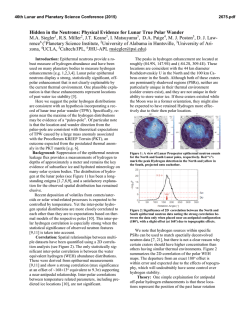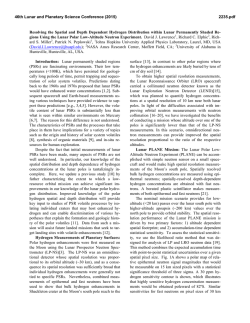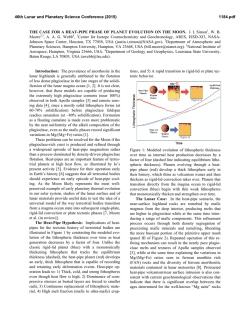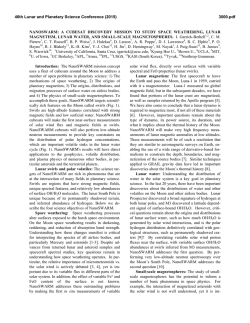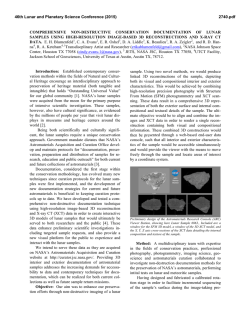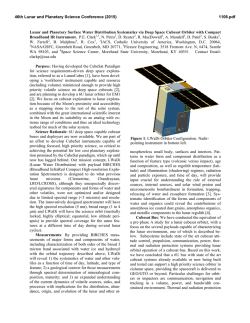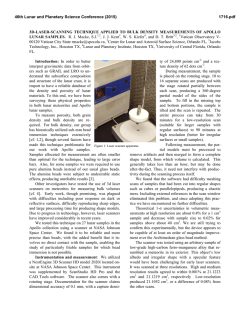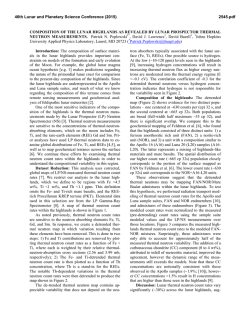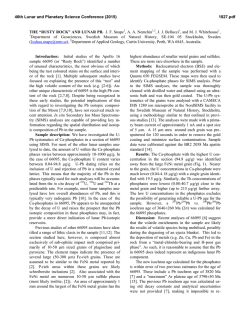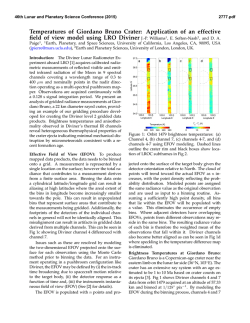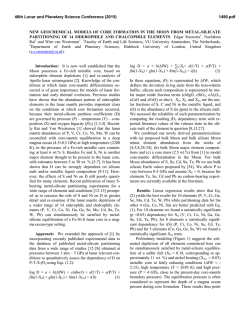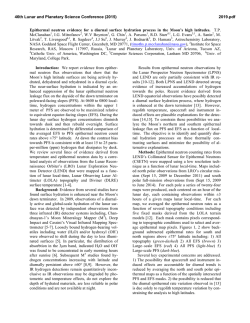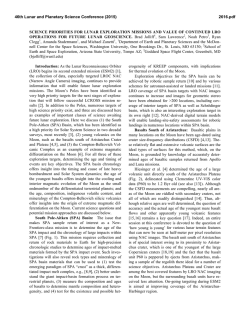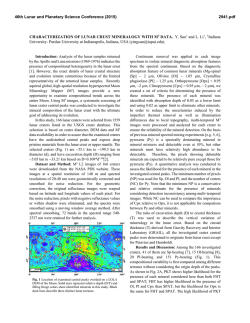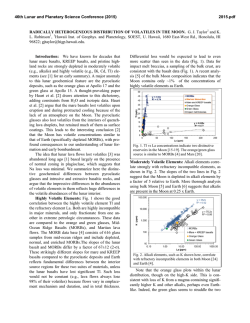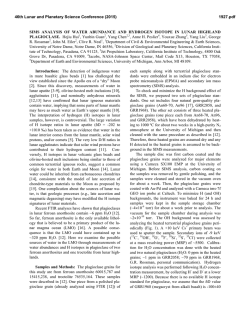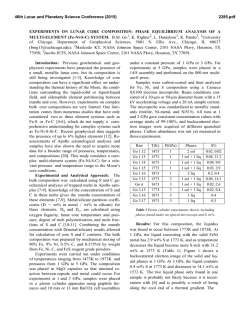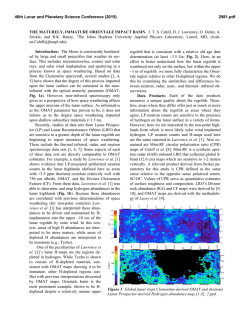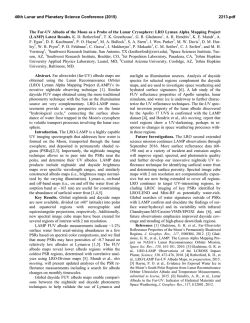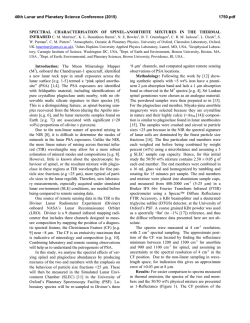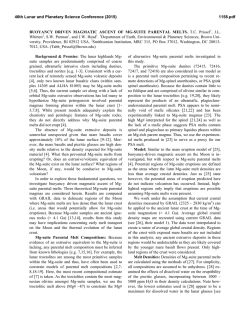
The Quest for a Diurnal Effect in Lunar Hydrogen Abundance
46th Lunar and Planetary Science Conference (2015) 1786.pdf Lu´ıs F.A. Teodoro1 , David J. Lawrence , Richard C. Elphic , Vincent R. Eke , William C. Feldman , Sylvestre Maurice6 , Matthew Siegler5 and David Paige8 1 BAER, NASA Ames Research Center, Moffett Field, CA 94035-1000 ([email protected]); 3 Planetary Systems Branch, Space Sciences and Astrobiology Division, MS 245-3, NASA Ames Research Center, Moffett Field, CA 94035-1000, USA; 4 Institute for Computational Cosmology, Department of Physics, Durham University, Science Laboratories, South Road, Durham DH1 3LE, UK; 5 Planetary Science Institute, 1700 E. Fort Lowell, Suite 106, Tucson, AZ, 85719, USA; 6 Universit´e Paul Sabatier, Centre d’Etude Spatiale des Rayonnements, 9 avenue Colonel Roche, B.P. 44346 Toulouse, France; 7 Department of Earth, Planetary, and Space Sciences, University of California, Los Angeles, CA 90095, USA THE QUEST FOR A DIURNAL EFFECT IN LUNAR HYDROGEN ABUNDANCE 2 3 Introduction: The mapping of hydrogen in the near surface of the Moon has been one of the focal points of the human exploration of the Moon. Neutron spectroscopy has been central to this endeavor and allows one to probe the top few decimeters [1]. Here, we present an updated study of the daily variations of the Lunar Prospector epithermal neutron spectrometer count rates to inquire if such potential variations are sensitive to daily variations in H concentrations. This study is prompted, in part, by a report of time variable concentrations of (top tens of microns) H2 O/OH that have been observed with spectral reflectance data [2]. If such time variable H concentrations extend to macroscopic depths of multiple mm to cm then such variations could in principle be observed with orbital neutron data. Preliminary analysis of data from the Lunar Exploration Neutron Detector has shown a diurnal count rate variation, which has been interpreted as daily variations in H concentrations [3]. Such extraordinary findings, if confirmed, could lead to deep consequences on our understanding of the hydrogen distribution at the lunar surface. Here, we show that the Lunar Prospector Neutron Spectrometer (LP-NS) epithermal neutron count rates also exhibit diurnal variations, but these variations are correlated with variations in instrumental and sub-surface lunar temperatures. In this work we use the epithermal neutron dataset gathered by the LP-NS, which is in the public domain at the Planetary Data System (PDS).1 We also use temperature measurements of the lunar surface collected by the Diviner Lunar Radiometer on Lunar Reconnaissance Orbiter. These measurements are also available at PDS.2 We will also use thermal models that have been constrained by the above thermal measurements [4]. 1 http://pds-geosciences.wustl.edu/missions/ lunarp/ 2 http://pds-geosciences.wustl.edu/missions/ lro/diviner.htm 4 5 Figure 1: Count rate versus LPNS sensor temperature scatter diagram. Red line shows the linear fit to the data. To quantify the variability of the epithermal count rate, cr(x, t), we introduce the random over count rate variable, δcr(x, t)/cr: δcr(x, t)/cr = cr(x, t)/crf (x, t) − 1 (1) where crf (x, t) is the fiducial count rate maps at 6pm (local time), x is the location on the lunar surface and t denotes local time. To quantify cr(x, t) we use the time-series defined as follows: all the instants of the overall LP-NS time-series within the latitude range |latitude| < 55◦ and low altitude (average ∼ 30 km) portion of the mission. In Figure 1 we show the LP-NS count rate versus sensor temperature. The top panel of Figure 2 shows the count rate averaged over the latitude domain for uncorrected (green) and sensor temperature corrected (violet) data. The sensor temperature corrections alone reduce the over count variations from ∼ 2.73% down to ∼ 1.60%. Little et al (2003) [5] and Lawrence et al (2006) [6] used a Monte Carlo approach to study neutron transport in typical lunar soils and showed that both thermal and epithermal neutron count rates are dependent on temperature. In this work we consider a variety of subsurface temperatures as a function of both lati- 46th Lunar and Planetary Science Conference (2015) tude and local time, as constrained by the Diviner measurements. To take into account the effects of the lunar subsurface temperature we consider an “averagesoil” made up of equal fractions of Luna 16, 20, 24, Apollo 11 and FAN (see [6] for further details regarding the lunar soils). In the upper panel of Figure 2 we show the averaged over count rate corrected for sensor temperature and surface temperature effects (black). In the lower panel of the same figure we present the over count rate as corrected for sub-surface temperatures at different depths. In Table 1 we present the peak-to-peak variation of the over count rate for different subsurface temperature corrections. The minimum variation occurs for a sub-surface depth of 20 cm. Conclusions: LP-NS epithermal neutron count rates also show diurnal variations, however, these variations are correlated with variations in instrumental temperature and with the sub-surface temperatures as constrained by the Diviner measurements. These findings suggest that rather than reflecting diurnal changes in hydrogen, the temporal fluctuations in the count rates are due to residual systematic effects in the data reduction which have not been taken into account in previous studies [7]. After corrections for instrumental and subsurface temperature, the remaining diurnal count rate variations are ∼ 0.5%. An additional result is that we have made the first measurement of the effective leakage depth for epithermal neutrons of 10 - 20 cm. When these depths are used for sub-surface temperature correction, they lead to the lowest diurnal variations in the epithermal neutron data. References: [1] W. C. Feldman, et al. (1998) Science 281:1496 doi:10.1126/science.281.5382.1496. [2] J. M. Sunshine, et al. (2009) Science 326:565 doi:10.1126/science.1179788. [3] T. A. Livengood, et al. (2014) in Lunar and Planetary Science Conference vol. 45 of Lunar and Planetary Science Conference 1507. [4] M. A. Siegler, et al. (2011) Journal of Geophysical Research (Planets) 116:E03010 doi:10.1029/2010JE003652. [5] R. C. Little, et al. (2003) Journal of Geophysical Research (Planets) 108:5046 doi:10.1029/2001JE001497. [6] D. J. Lawrence, et al. (2006) Journal of Geophysical Research (Planets) 111(E10):8001 doi:10.1029/2005JE002637. [7] S. Maurice, et al. (2004) Journal of Geophysical Research (Planets) 109:E07S04 doi:10.1029/2003JE002208. 1786.pdf Figure 2: Upper panel Count rate versus local time. Sensor and Surface Temperature corrected (black), Sensor Temperature corrected (violet) and Uncorrected Low altitude 2 data (green) Lower panel Subsurface temperature corrected count rate vs local time for different depths. The color scheme is shown in the panel. LPNS sub-dataset hδcrimax − hδcrimin ×10−2 Low altitude 2.73 Temperature Sensor corrected 1.60 Depth 0 cm Depth 1 cm Depth 2 cm Depth 3 cm Depth 4 cm Depth 5 cm Depth 10 cm Depth 20 cm Depth 30 cm 0.92 0.92 0.98 1.08 1.08 0.98 0.57 0.49 0.92 Table 1: Peak-to-peak variation of the average count rate in two hour local time bins for the different time series considered in this work.
© Copyright 2026
